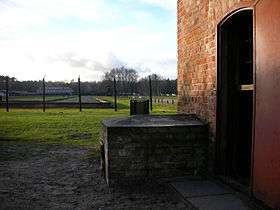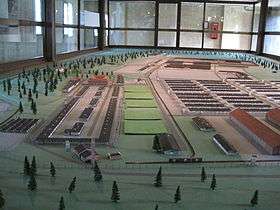Sztutowo
Sztutowo (German: Stutthof) is a small (about 3,000 inhabitants) village outside Gdansk in Poland. Once it was famous only as the birthplace of the German philosopher Arthur Schopenhauer, but unfortunately that was to change. Today it is known as the site of the Nazi Stutthof concentration camp, the first concentration camp to be built outside Germany.

Get in
Sztutowo is 52 kilometers east from Gdansk and the trip takes about an hour in jam-free traffic. The village is located 25 kilometers northwest of Elbląg and the drive by car should take approximately 40 minutes. Hourly buses to Krynica Morska go from platform 2 at the Gdańsk bus terminal and stop at Sztutowo. The ticket is bought on the bus for about 10 zł. Sit close to the driver if you feel uncertain about where to get off.
Buses between Elbląg and Krynica Morska also stop in Sztutowo.
See


The Stutthof concentration camp is the reason to go here, and it is the closest destination for visitors to the Gdansk area who wish to experience a concentration camp for remembrance of the Holocaust. You will have to backtrack about a kilometer from the bus stop to get to the museum, which is marked with a large sign. During high season, May-September, it is open 8AM to 6PM, in low season it closes at 3PM. On Mondays there are no guided tours, also there are no films shown. Children under 13 years of age are not allowed.
The very peaceful and quiet setting of the camp makes it hard at first to comprehend the horrors that took place here, despite the barbed wire and the watchtowers. However, as you enter the barracks and see the pile of shoes from the victims and the exhibitions describing the efficiency and brutality of the Nazi killers, it all starts getting under your skin.
Construction of the camp began in 1939, before the war started. It was then a civilian internment camp for Poles from the Free City of Danzig (which was under Nazi government). The camp grew during the war, from housing 3,500 prisoners to 57,000. In 1942 it was turned into an international concentration camp, and in June 1944 it was incorporated into the ultimate evil of Hitler's "Final Solution". From then on, Stutthof was a pure extermination camp.
The walk through the camp area ends by the gas chamber and the crematory which were added in 1943. Mobile gas wagons were also used when extra killing capacity was needed. The nightmare in Stutthof claimed somewhere between 65,000 and 85,000 lives before the Red Army liberated the camp in May 1945.
Buy
Eat
Drink
Sleep
- 🌍 Guesthous Zacisze, ul. Słoneczna 1, ☎ +48 506 393 040. A lovely guesthouse run by a young, energetic and welcoming Polish couple. Families are welcome, and the guesthouse is located near to the sea. 80zl.
Go next
When you arrive in Sztutowo from Gdansk, the bus stop for the return trip is on the other side of the road about 1 km to Gdynia Morska.